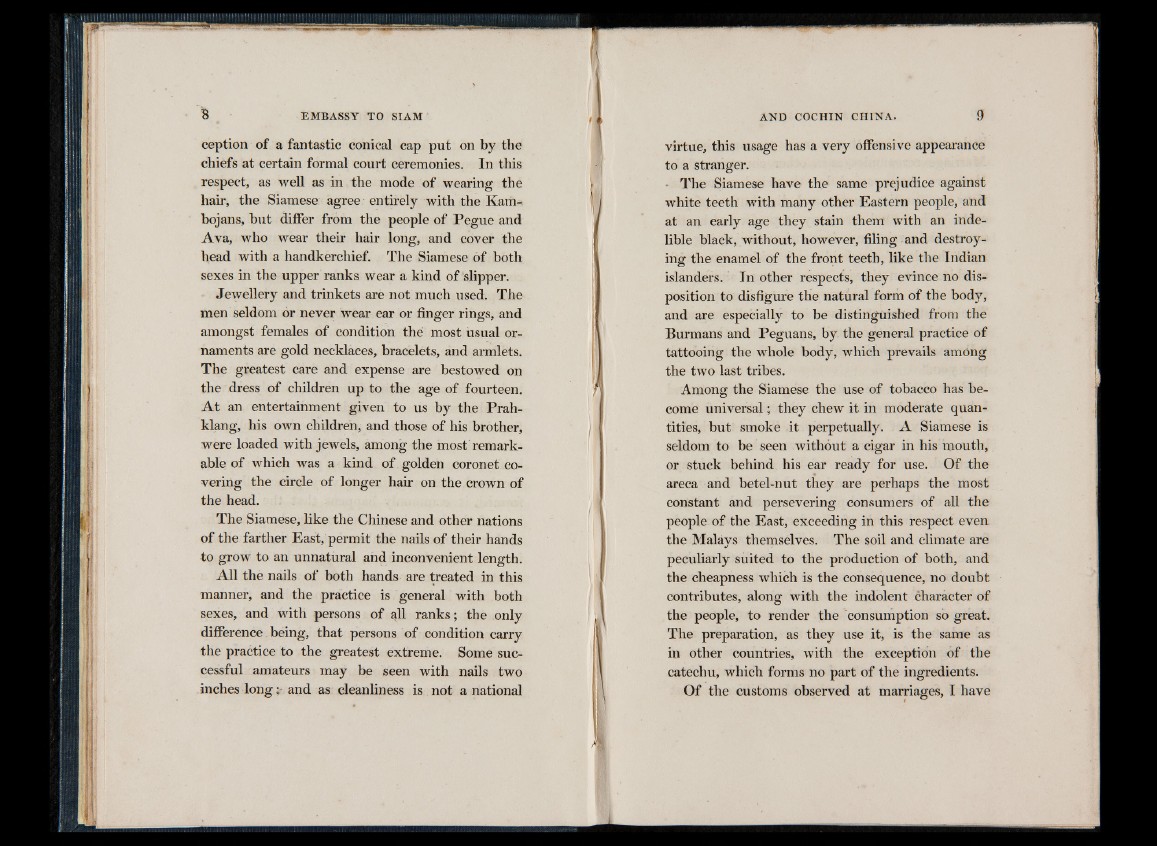
ception of a fantastic conical cap put on by the
chiefs at certain formal court ceremonies. In this
respect, as well as in the mode of wearing the
hair, the Siamese agree entirely with the Kam-
bojans, but differ from the people of Pegue and
Ava, who wear their hair long, and cover the
head with a handkerchief. The Siamese of both
sexes in the upper ranks wear a kind of slipper.
Jewellery and trinkets are not much used. The
men seldom or never wear ear or finger rings, and
amongst females of condition the most usual ornaments
are gold necklaces, bracelets, and armlets.
The greatest care and expense are bestowed on
the dress of children up to the age of fourteen.
A t an entertainment given to us by the Prah-
klang, his own children, and those of his brother,
were loaded with jewels, among the most remarkable
of which was a kind of golden coronet covering
the circle of longer hair on the crown of
the head.
The Siamese, like the Chinese and other nations
of the farther East, permit the nails of their hands
to grow to an unnatural and inconvenient length.
All the nails of both hands are treated in this
manner, and the practice is general with both
sexes, and with persons of all ranks; the only
difference being, that persons of condition carry
the practice to the greatest extreme. Some successful
amateurs may be seen with nails two
inches lo n g ; and as cleanliness is not a national
virtue, this usage has a very offensive appearance
to a stranger.
• The Siamese have the same prejudice against
white teeth with many other Eastern people, and
at an early age they stain them with an indelible
black, without, however, filing and destroying
the enamel of the front teeth, like the Indian
islanders. In other respects, they evince no disposition
to disfigure the natural form of the body,
and are especially to be distinguished from the
Burmans and Peguans, by the general practice of
tattooing the whole body, which prevails among
the two last tribes.
Among the Siamese the use of tobacco has become
universal; they chew it in moderate quantities,
but smoke it perpetually. A Siamese is
seldom to be seen without a cigar in his mouth,
or stuck behind his ear ready for use. Of the
areca and betel-nut they are perhaps the most
constant and persevering consumers of all the
people of the East, exceeding in this respect even
the Malays themselves. The soil and climate are
peculiarly suited to the production of both, and
the cheapness which is the consequence, no doubt
contributes, along with the indolent character of
the people, to render the consumption so great.
The preparation, as they use it, is the same as
in other countries, with the exception of the
catechu, which forms no part of the ingredients.
Of the customs observed at marriages, I have